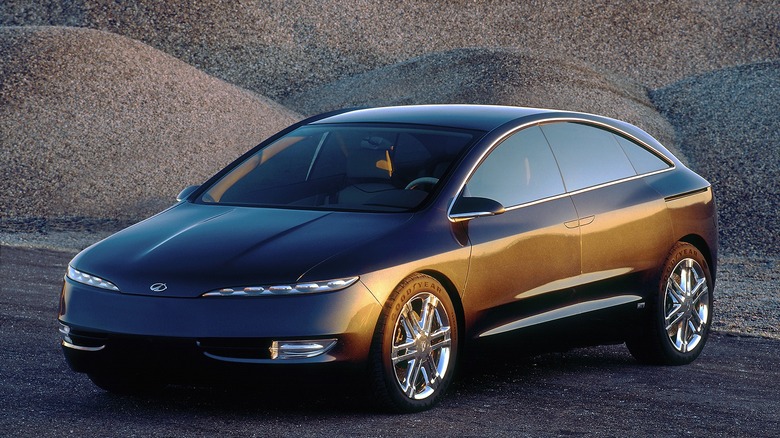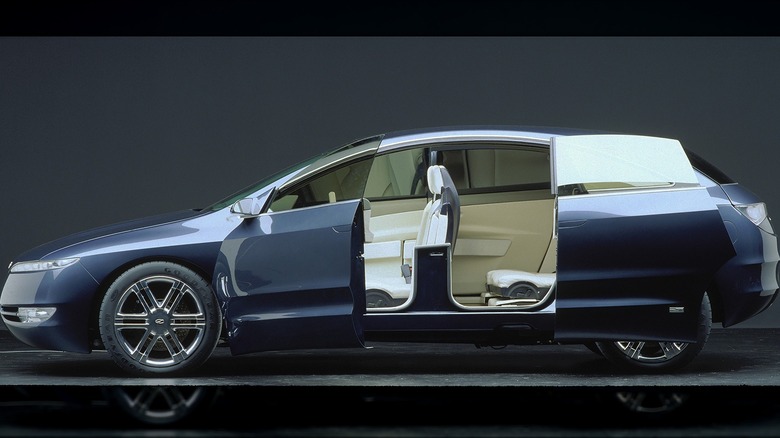The Oldsmobile Concept Car That Was Way Ahead Of Its Time
Some automotive brands are short lived, and offer little in the way of a storied legacy, such as GM's Geo. Conversely, there are several important moments in the history of the Oldsmobile, and the brand lasted over a century, contributing significantly to the industry that can still be felt today. One of its last attempts at reinventing itself, the automaker revealed a concept car, called the Oldsmobile Profile just prior to the turn of the 21st century.
The Profile was very forward thinking and incorporated technology unheard of at the time, but would later be featured in yet to be released models, like the Tesla Model X, and Chrysler 200, among others. Well before Elon Musk's Model 3 released in 2017, this Oldsmobile incorporated a "Smart Card" technology, which functioned like a traditional key, allowing access to the vehicle, the ability to start the car, and more. While rotary shift knobs are available on a variety of models such as the Chrysler Pacifica and 200, as well as the Jaguar XF, the Profile offered this design back in 2000.
This wasn't the Profile's only attempt at upping the ante, it also offered a hands-free cell phone system using Bluetooth, and the ability to connect to the internet. Although, details of the full functionality of these advanced features were a bit fuzzy from the automaker. Still, these would later become mainstream modern additions to many models across the industry.
The Profile predicted future design trends
While the crossover did exist in 2000, it hadn't yet taken root with American drivers, as the genre only represented around 4 percent of the market, according to Consumer Reports. Today, the most popular SUVs in 2025, are all crossovers, which include the RAV4, Honda CR-V, Chevy Equinox, and Tesla Model Y, per Kelly Blue Book. While it may not have been the first crossover, the Oldsmobile Profile successfully predicted the direction the industry was headed. In fact, the promotional material surrounding this concept car described a fusing of utility with a sedan-like driving feel. Sound familiar?
Another nod to what would later become a trendy style is the Profile's door handles, which site perfectly flush with the door. These would later become fixtures on other brands such as Tesla's Model X. However, these aren't a hit with all drivers, especially those in colder regions where their Tesla's door handle is frozen shut on occasion. The Profile also doesn't look out of place among today's electric vehicles in terms of its absent front grille. However, unlike an EV, this concept was equipped with a supercharged 3.5-liter V6, that output 250 horsepower.
Why didn't Oldsmobile bring the Profile into production?
Unfortunately, the brand had been suffering a significant decline in sales, with the '90s being a particularly rough period. Oldsmobile had been known for decades as a leader in innovative ideas, but when GM put several brands under the same roof, and the automaker began utilizing the same parts across its lineup, it became challenging for drivers to separate Buick and Oldsmobile models. Essentially, the brand lost its unique identity, and became lost among the shuffle of models from GM.
By the time the Profile was unveiled in 2000, General Motors was already set to drop Oldsmobile. Just four years later, the final model would leave the factory floor. While not everything about the Profile would have been a hit with drivers, (such as the minivan-like rear sliding doors), it was certainly an example of both designers and engineers at Oldsmobile finding the future pulse of consumers needs and wants. And perhaps, had the Profile somehow been put into production, it could've saved an iconic automotive brand on the brink.


